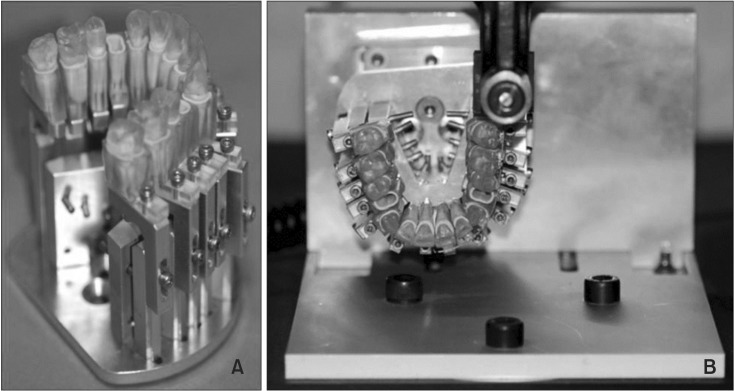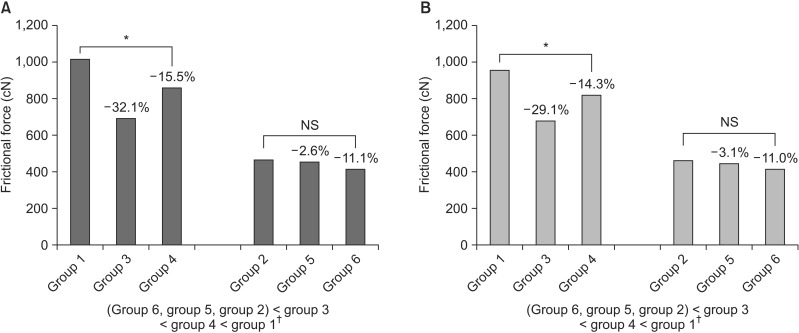Korean J Orthod.
2016 Mar;46(2):73-80. 10.4041/kjod.2016.46.2.73.
Effect of passive self-ligating bracket placement on the posterior teeth on reduction of frictional force in sliding mechanics
- Affiliations
-
- 1Department of Orthodontics, School of Dentistry, Seoul National University, Seoul, Korea. drwhite@unitel.co.kr
- 2Dental Research Institute, Seoul National University, Seoul, Korea.
- KMID: 2159354
- DOI: http://doi.org/10.4041/kjod.2016.46.2.73
Abstract
OBJECTIVE
The purpose of this study was to investigate the static (SFF) and kinetic frictional forces (KFF) in sliding mechanics of hybrid bracket systems that involve placing a conventional bracket (CB) or active self-ligating bracket (ASLB) on the maxillary anterior teeth (MXAT) and a passive SLB (PSLB) on the maxillary posterior teeth (MXPT).
METHODS
The samples consisted of two thoroughbred types (group 1, anterior-CB + posterior-CB; group 2, anterior-ASLB + posterior-ASLB) and four hybrid types (group 3, anterior-CB + posterior-PSLB-type 1; group 4, anterior-CB + posterior-PSLB-type 2; group 5, anterior-ASLB + posterior-PSLB-type 1; group 6, anterior-ASLB + posterior-PSLB-type 2) (n = 13 per group). After maxillary dentition alignment and maxillary first premolars removal in the stereolithographically-made typodont system, a 0.019 × 0.025-inch stainless steel wire was drawn through the right quadrant of the maxillary arch at 0.5 mm/min for 5 min. The SFF and KFF were measured with a mechanical testing machine and statistical analyses were performed.
RESULTS
Four different categories of SFF and KFF were observed among all groups (all p < 0.001). Group 1 demonstrated the highest SFF and KFF; groups 4 and 3 were second and third highest, respectively. The fourth category included groups 2, 5, and 6. Placing PSLBs on the MXPT resulted in significant SFF and KFF reductions in cases with CBs on the MXAT, but not in cases with ASLBs on the MXAT.
CONCLUSIONS
These data might aid in the development of a hybrid bracket system that enables low-friction sliding of an archwire through the MXPT.
Figure
Reference
-
1. Frank CA, Nikolai RJ. A comparative study of frictional resistances between orthodontic bracket and arch wire. Am J Orthod. 1980; 78:593–609. PMID: 6935961.
Article2. Arici N, Akdeniz BS, Arici S. Comparison of the frictional characteristics of aesthetic orthodontic brackets measured using a modified in vitro technique. Korean J Orthod. 2015; 45:29–37. PMID: 25667915.3. Shivapuja PK, Berger J. A comparative study of conventional ligation and self-ligation bracket systems. Am J Orthod Dentofacial Orthop. 1994; 106:472–480. PMID: 7977187.
Article4. Budd S, Daskalogiannakis J, Tompson BD. A study of the frictional characteristics of four commercially available self-ligating bracket systems. Eur J Orthod. 2008; 30:645–653. PMID: 18974067.
Article5. Kim TK, Kim KD, Baek SH. Comparison of frictional forces during the initial leveling stage in various combinations of self-ligating brackets and archwires with a custom-designed typodont system. Am J Orthod Dentofacial Orthop. 2008; 133:187.e15–187.e24. PMID: 18249279.
Article6. Krishnan M, Kalathil S, Abraham KM. Comparative evaluation of frictional forces in active and passive self-ligating brackets with various archwire alloys. Am J Orthod Dentofacial Orthop. 2009; 136:675–682. PMID: 19892284.
Article7. Cordasco G, Farronato G, Festa F, Nucera R, Parazzoli E, Grossi GB. In vitro evaluation of the frictional forces between brackets and archwire with three passive self-ligating brackets. Eur J Orthod. 2009; 31:643–646. PMID: 19797412.
Article8. Lee SM, Hwang CJ. A comparative study of frictional force in self-ligating brackets according to the bracket-archwire angulation, bracket material, and wire type. Korean J Orthod. 2015; 45:13–19. PMID: 25667913.
Article9. Heo W, Baek SH. Friction properties according to vertical and horizontal tooth displacement and bracket type during initial leveling and alignment. Angle Orthod. 2011; 81:653–661. PMID: 21306223.
Article10. Brauchli LM, Senn C, Wichelhaus A. Active and passive self-ligation-a myth? Angle Orthod. 2011; 81:312–318. PMID: 21208085.
Article11. Huang TH, Luk HS, Hsu YC, Kao CT. An in vitro comparison of the frictional forces between archwires and self-ligating brackets of passive and active types. Eur J Orthod. 2012; 34:625–632. PMID: 21765175.
Article12. Pizzoni L, Ravnholt G, Melsen B. Frictional forces related to self-ligating brackets. Eur J Orthod. 1998; 20:283–291. PMID: 9699406.
Article13. Thorstenson GA, Kusy RP. Resistance to sliding of orthodontic brackets with bumps in the slot floors and walls: effects of second-order angulation. Dent Mater. 2004; 20:881–892. PMID: 15451244.
Article14. Hain M, Dhopatkar A, Rock P. A comparison of different ligation methods on friction. Am J Orthod Dentofacial Orthop. 2006; 130:666–670. PMID: 17110266.
Article15. Stefanos S, Secchi AG, Coby G, Tanna N, Mante FK. Friction between various self-ligating brackets and archwire couples during sliding mechanics. Am J Orthod Dentofacial Orthop. 2010; 138:463–467. PMID: 20889052.
Article16. Badawi HM, Toogood RW, Carey JP, Heo G, Major PW. Torque expression of self-ligating brackets. Am J Orthod Dentofacial Orthop. 2008; 133:721–728. PMID: 18456146.
Article17. Rinchuse DJ, Miles PG. Self-ligating brackets: present and future. Am J Orthod Dentofacial Orthop. 2007; 132:216–222. PMID: 17693372.
Article18. Paik CH, Ahn HW, Yang IH, Baek SH. Low-friction space closure with a hybrid bracket-tube system. J Clin Orthod. 2010; 44:623–627. quiz 622PMID: 21275318.19. Seo YJ, Lim BS, Park YG, Yang IH, Ahn SJ, Kim TW, et al. Effect of tooth displacement and vibration on frictional force and stick-slip phenomenon in conventional brackets: a preliminary in vitro mechanical analysis. Eur J Orthod. 2015; 37:158–163. PMID: 25023028.
Article20. Nakago T, Mitani S, Hijiya H, Hattori T, Nakagawa Y. Determination of the tooth mobility change during the orthodontic tooth movement studied by means of Periotest and MIMD (the mechanical impedance measuring device for the periodontal tissue). Am J Orthod Dentofacial Orthop. 1994; 105:92–96. PMID: 8291499.
Article21. Tanaka E, Ueki K, Kikuzaki M, Yamada E, Takeuchi M, Dalla-Bona D, et al. Longitudinal measurements of tooth mobility during orthodontic treatment using a periotest. Angle Orthod. 2005; 75:101–105. PMID: 15747823.22. Henao SP, Kusy RP. Evaluation of the frictional resistance of conventional and self-ligating bracket designs using standardized archwires and dental typodonts. Angle Orthod. 2004; 74:202–211. PMID: 15132446.23. Andrews LF. The six keys to normal occlusion. Am J Orthod. 1972; 62:296–309. PMID: 4505873.
Article24. Henao SP, Kusy RP. Frictional evaluations of dental typodont models using four self-ligating designs and a conventional design. Angle Orthod. 2005; 75:75–85. PMID: 15747819.25. Ehsani S, Mandich MA, El-Bialy TH, Flores-Mir C. Frictional resistance in self-ligating orthodontic brackets and conventionally ligated brackets. A systematic review. Angle Orthod. 2009; 79:592–601. PMID: 19413397.26. Franchi L, Baccetti T, Camporesi M, Barbato E. Forces released during sliding mechanics with passive self-ligating brackets or nonconventional elastomeric ligatures. Am J Orthod Dentofacial Orthop. 2008; 133:87–90. PMID: 18174077.
Article27. Major TW, Carey JP, Nobes DS, Heo G, Major PW. Mechanical effects of third-order movement in self-ligated brackets by the measurement of torque expression. Am J Orthod Dentofacial Orthop. 2011; 139:e31–e44. PMID: 21195255.
Article28. Brauchli LM, Steineck M, Wichelhaus A. Active and passive self-ligation: a myth? Part 1: torque control. Angle Orthod. 2012; 82:663–669. PMID: 22059468.
Article29. Chung M, Nikolai RJ, Kim KB, Oliver DR. Third-order torque and self-ligating orthodontic bracket-type effects on sliding friction. Angle Orthod. 2009; 79:551–557. PMID: 19413378.
Article
- Full Text Links
- Actions
-
Cited
- CITED
-
- Close
- Share
- Similar articles
-
- A comparative study of frictional force in self-ligating brackets according to the bracket-archwire angulation, bracket material, and wire type
- A comparative study of frictional resistances between orthodontic brackets and arch wire during sliding movement of teeth
- A study on frictional resistance force of orthodontic resin bracket
- The effect of bracket width on frictional force between bracket and arch wire during sliding tooth movement
- Comparison of the frictional resistance between orthodontic bracket & archwire



